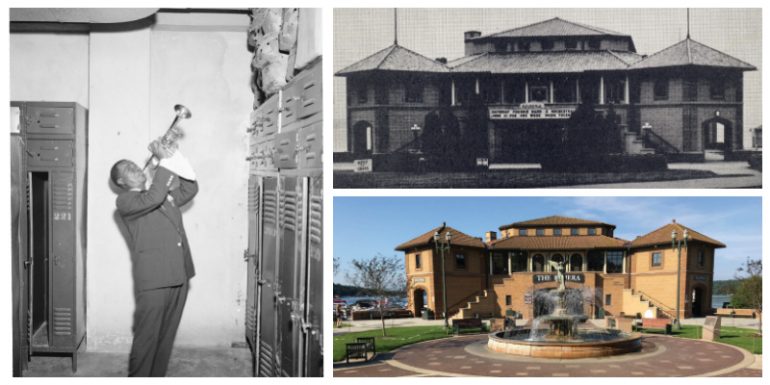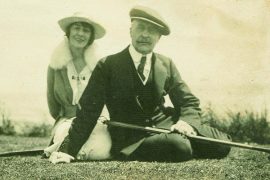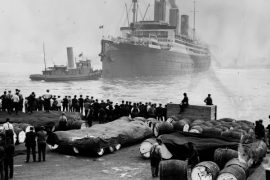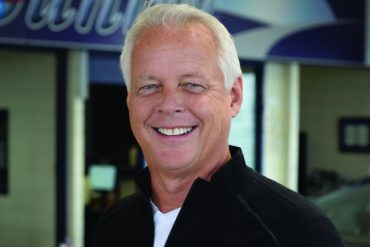By Anne Morrissy
For five months, the residents of Lake Geneva had watched with riveted interest as the impressive Italianate civic building rose out of the lake. The year was 1932, one of the worst years of the Great Depression. People were out of work and eager for distraction. City leaders selected architect James Roy Allen, a Chicagoan who had relocated to Lake Geneva just a few years earlier, to design it. On the first floor of the building, Allen’s original plans included stalls for shops and food stands, as well as a bathhouse with men’s and women’s locker rooms. Upstairs, Allen designed a large ballroom flanked by a long, west-facing loggia.
Although the Riviera would not officially open until the following year, a local “soft open” was held on September 1, 1932, with the Ralph Williams Orchestra providing the music. Newspaper accounts of the night indicate the building was “crowded to four walls.” The official opening in May of 1933 featured a well-known Chicago Big Band – Wayne King and his Famous Aragon Ballroom Band. From its earliest days, Lake Geneva’s public ballroom drew crowds who came to dance the night away while overlooking Geneva Bay.
THE BIG BAND HEYDAY
According to Dr. Mark Braden, the city began leasing the Riviera to his great-uncle, Lake Geneva businessman Ralph E. Braden, around 1935, beginning a relationship with the Braden family that would last until 1980. Ralph Braden became the public face of the Riviera, and his skills at booking bands led to several big names of the Big Band era swinging through Lake Geneva for single-night engagements.
When Mark Braden’s father Berwyn “Buzz” Braden got out of the service after WWII, he joined his uncle Ralph in managing the Riviera.
Williams Bay High School alum Dick Campbell worked at the Riviera as a teenager from 1949 to 1951, and he says the ballroom was a lively scene during that time.
“We’d have a Big Band every weekend in the summer,” he remembers. “The place was packed. There was dancing going on the whole time. And people really got dressed up.”
Beginning in the 1950s, the Riviera hit its stride as a ballroom and attracted national jazz superstars and their bands: Les Brown, Tex Beneke, Dave Brubeck, the Glenn Miller Orchestra, Stan Kenton and more. Perhaps most famously, in 1954, the great Louis Armstrong gave his first performance at the Riviera, and he would return every summer for the next decade. “I remember on the nights Louis Armstrong played, you could stand at the top stairs and see people lined up two by two all the way from the entrance of the Riviera to Flat Iron Park, dressed in their tuxedos and ball gowns,” Dr. Mark Braden remembers.
Many local residents have fond memories of seeing the jazz great in this relatively intimate setting, but Harold Friestad, retired manager of the Lake Geneva Cruise Line, had a particularly memorable encounter with the great “Satchmo” around 1961. “I was driving the Polaris that summer and we had a record player on the boat. So, after the concert that night, I walked down and got my “Ambassador Satch” record and then came around to the side of the building, to the beach house shower rooms downstairs. Louie’s in there changing and I walked right up to him and said, ‘Will you please sign this for me?’ He signed both sides of it.”
THE TRANSITION TO ROCK ‘N’ ROLL
As the 1950s progressed, Big Band Swing started to fade from popularity as a new music genre swept the nation: rock ‘n’ roll. In 1955, the Bradens experimented with the lineup by scheduling a teenagers-only show featuring The Crew Cuts, who had a huge pop chart success the previous year with “Sh-Boom.” Other early pop/rock acts followed in the late 1950s and early 1960s – the Noblemen, the Echoes, the Chordettes – though the summer schedule was still dominated by dance bands like the Val Eddy Orchestra and Hal Iverson Trio. However, by the 1960s, the once grand Riviera ballroom was suffering from decades of wear and tear. In 1965, the building was in need of major repairs and renovations and a Chicago real estate developer began to float the idea of tearing it down to construct a massive convention center and parking lot in its place. (The city council never approved the plan.) Despite the Riviera’s condition, top talent occasionally still stopped by on tour. In 1969, Stevie Wonder appeared at the Riviera for one night only.
THE TOP DECK
Around the time of Ralph E. Braden’s death in 1970, the Braden family decided to sublet the ballroom space to George Borg, former state senator and heir to the Borg-Warner fortune. Borg invested a significant sum of money to reconfigure the interior and convert it from a ballroom to a slick bar and nightclub called the Top Deck. When Borg died in a motorcycle accident the following year, Buzz Braden bought the Top Deck Corporation, just as Wisconsin changed state law and lowered the drinking age from 21 to 18.
Thomas “Murph” Morrissy (the author’s father) worked as a bartender at the Top Deck from 1972 to 1974. “When that change went into effect, the place was packed, especially on the weekends,” he remembers. “Some weekends we had 1,000 people in there. On weekend nights in the summer, we had seven bartenders on shift at once, seven different bar stations, each with our own register. On good nights, I would take in $1,000 in a single night at my register alone.”
Dr. Mark Braden helped his father run the Top Deck from 1972 to 1979, booking bands like Chubby Checker, Herman’s Hermits, Gary Puckett & the Union Gap, Gary Lewis & the Playboys, the Ides of March and The Cryin’ Shames. “It was one of the primary nightclub spots in the whole Midwest from that era,” he explains. “Lake Geneva in general was the place to come back then and the Top Deck was where everyone wanted to be. That was the heyday of the Riviera for my generation. The bar was packed. We’d open at 7 p.m., and we’d have so many people that we’d have to shut the doors by 9 p.m.”
According to Braden, they saw so much success with the Top Deck during the summer that his father decided to experiment by keeping the bar open on weekends into the fall. “We were just as packed after Labor Day as we were during the summer,” Morrissy remembers. “[He] ended up leaving it open on Friday and Saturday nights through the whole winter, though the building was not very well insulated.”
However, not everyone in Lake Geneva loved the Top Deck as much as the younger generation did. The bar gained a reputation as a wild place, and this created some tension among residents who felt it attracted a rowdy and disrespectful crowd to the lakefront. When the lease expired Dec. 31, 1979, the city chose to resume management of the Riviera and closed the Top Deck, bringing an era to an end.
A NEW LEASE ON LIFE
By 1980, though the stalls on the Riviera’s first floor still housed popular shops and the pier itself was still thriving (both Gage Marine’s Lake Geneva Cruise Line and the Water Safety Patrol headquarters had called the pier home for decades), the Riviera Ballroom sat effectively abandoned, an “empty shell with a very questionable and dubious future,” according to one writer at the time. Ultimately, city leaders decided to invest $350,000 in the future of the Riviera Ballroom, hiring architect Dan Curran to oversee a massive renovation and restoration project intended to return the building to a state close to its original 1932 design. It was no small undertaking. “When I first walked in here, it looked like the place had been gutted by fire, and a bomb had gone off,” Curran remembered a few years later.
Curran and city leaders reimagined the space as a civic building available to rent for private events like weddings, banquets and proms, and set about restoring the grand space for this purpose. The interior portion of the project was completed in 1983. The renovations proved extremely successful: after reopening, the building maintained a busy schedule of private events, and in 1986, the newly restored Riviera building received landmark status and was placed on the National Register of Historic Places.
THE RIVIERA INTO THE FUTURE
Today, 36 years after that massive renovation project, the Riviera is the subject of public discussion as the building once again needs significant repairs and renovation. According to Lake Geneva Mayor Tom Hartz, “We’ve made a real effort to reach out into the community and we have solicited a lot of ideas about what people remember about the Riviera, but also what they would like to see going forward.” Hartz says the first phase of the repairs will be a roof replacement this fall, with other updates to follow. (Because of the landmark status, any repairs or changes must first be approved by the State Historic Preservation Office.)
Hartz is hopeful that once this round of repairs and updates is completed in the next few years, the building will be a marquis community space once again. “The folks running the city in 1932 figured out that it was important to have a publicly owned building on the lakefront that offered a place for people to enjoy the water,” he said. “Most lake communities don’t have that.”
Friestad concurs, summing up a feeling common among many local residents: “It’s such a special place.”






Comments are closed.